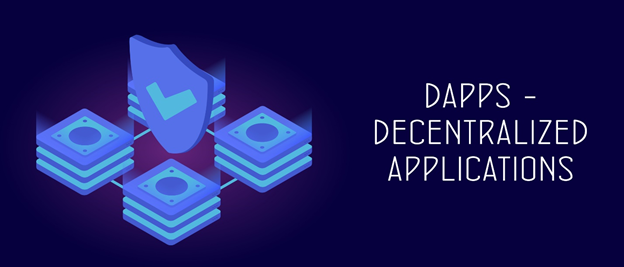What is a Decentralised Application (DApp)?
Decentralisation means independence or having separate control from a group. A decentralised application (DApp) is therefore built on an independent peer-to-peer network blockchain. A DApp has its own backend code, frontend code and user interface. Its' frontend can be hosted on a decentralised storage. DApps do not need a central authority to function. They allow direct interaction between users and application providers. DApps perform irrespective of their network environment. It means giving the required computational resources, DApps can perform any action individually. Even if there is a bug in the operational network, it won't affect the functioning of the DApp. DApps are decentralised because of the inherent coding logic. Therefore, DApps require careful designing and testing.
Summary
- A decentralised application (DApp) is therefore built on a decentralised peer-to-peer network.
- DApps facilitate decentralisation along with secure blockchain data.
- DApps offer zero downtime and protection from malicious attacks over normal applications on a blockchain.
Frequently Asked Questions (FAQ)-
What are the features of DApp?
Generally, DApps have the following common features:
- Decentralised Applications run on a blockchain network. The backend code of a DApp runs on a blockchain.
- DAPPs also store all their data on a blockchain.
- Often, they have open-source code.
- DApps operate autonomously without any person or group controlling majority tokens.
- DApp tokens are created and used to provide value to the contributing nodes.
- Users can exchange tokens; access is granted to them.
- Often miners on DApps are rewarded with tokens for any successful contribution to the ecosystem.

Source: © 204474 | Megapixl.com
What are the uses of Decentralised Application?
DApps facilitate decentralisation along with secure blockchain data. Because of this, they can have various use cases. A few utilities of creating a DApp are:
- It facilitates money management; users of DApps can transact with each other over a blockchain network, using the blockchains intrinsic cryptocurrency. For example, the CTSI token of the Cartesi blockchain network can be used for money management and transactions over it. Users can even mine for more cryptocurrency or trade them for other tokens or fiat currencies.
- DApps also allow payment processing. There is no need to integrate with a bank or a fiat payment provider to process payments. Users can transact directly using cryptocurrencies they have mined or traded on the blockchain.
- Anonymous transactions are facilitated. Verification of user credentials is not needed on DApps. They use a system of public and private keys, with which users can transact transfer data easily. The degrees of anonymity may vary for each DApp. However, they end lengthy registration processes earlier required for transactions.
- It facilitates data security and audit on the blockchain. DApps provide users with a way of incurring secure, auditable transactions or transfers. The open-source DApp code is easily accessible and very much understandable to users. It has inherent transparency and security of the enclosed data. Since it works on blockchain, the data is even auditable and easy to access by third-party auditors.
- DApps can integrate money with real-world events. It is accomplished with funds on the blockchain. Both the buyer and seller can enter a smart contract to facilitate real-world transactions on DApps. For example, Tesla accepting Bitcoins on EV sales.
- Decentralised Autonomous Organisations (DAOs) can be formed on the blockchain. These leaderless organisations run on programme defined rules on the DApp. Members can vote or transact businesses and decide how tokens, funds, or value are exchanged. Members do not need to be on the exact geographic location.
What are the Advantages of decentralised applications?

Source: © Ileezhun | Megapixl.com
DApps have the following advantages over regular applications.
- They are fault-tolerant as they do not have a single point of failure and are distributed by default.
- DApps prevent violation of net censorship since no central authority can govern it.
- Blocking a DApp's domain or IP address is impossible, as DApps are not accessed via a particular IP address or domain. Though governments can track individual nodes in the network and shut them down, a DApp has numerous dispersed nodes.
- It is easy for users to trust DApps as they are not controlled by a single user who could cheat others.
- DApps offer zero downtime. Once the core smart contract is deployed on the blockchain, the network will always be available to clients seeking interaction with the contract.
- Hackers cannot launch malicious attacks targeting individual DApps.
- Privacy is another benefit as users don't need to provide real-world identities interact on a DApp.
- There is complete data integrity. The data stored on the blockchain is irreversible because of its cryptographic nature. Forging data is also not possible.
- DApps offer trustworthy and verifiable intelligent contracts. There is no chance of misuse or tampering with data.
What are the disadvantages of decentralised applications?
DApps cannot be termed foolproof. Like every other system, even DApps have certain disadvantages. A few of these are the following.
- It is challenging to fix bugs or update the DApp since all peers on the network need to update their node software.
- Some DApps may require identity verification. The level of identity secrecy varies, but there is no central authority doing so.
- It is challenging to build DApps since they have complex protocols for consensus. Part by part building and implementation of an idea is difficult due to the reasons mentioned above.
- Scaling the DApp is also not easy as security, transparency, and trustworthiness are needed. Every node runs and stores every transaction on a DApp, which makes processing a bit time-consuming.
- Sometimes users may face network congestion. If one DApp is using a lot of computational resources, the entire network gets backed up. However, this is being taken care of in the newer, more advanced versions.
- An average end may find it complex. For a user, it might be challenging to set up a tool stack needed for blockchain interaction.
 Please wait processing your request...
Please wait processing your request...